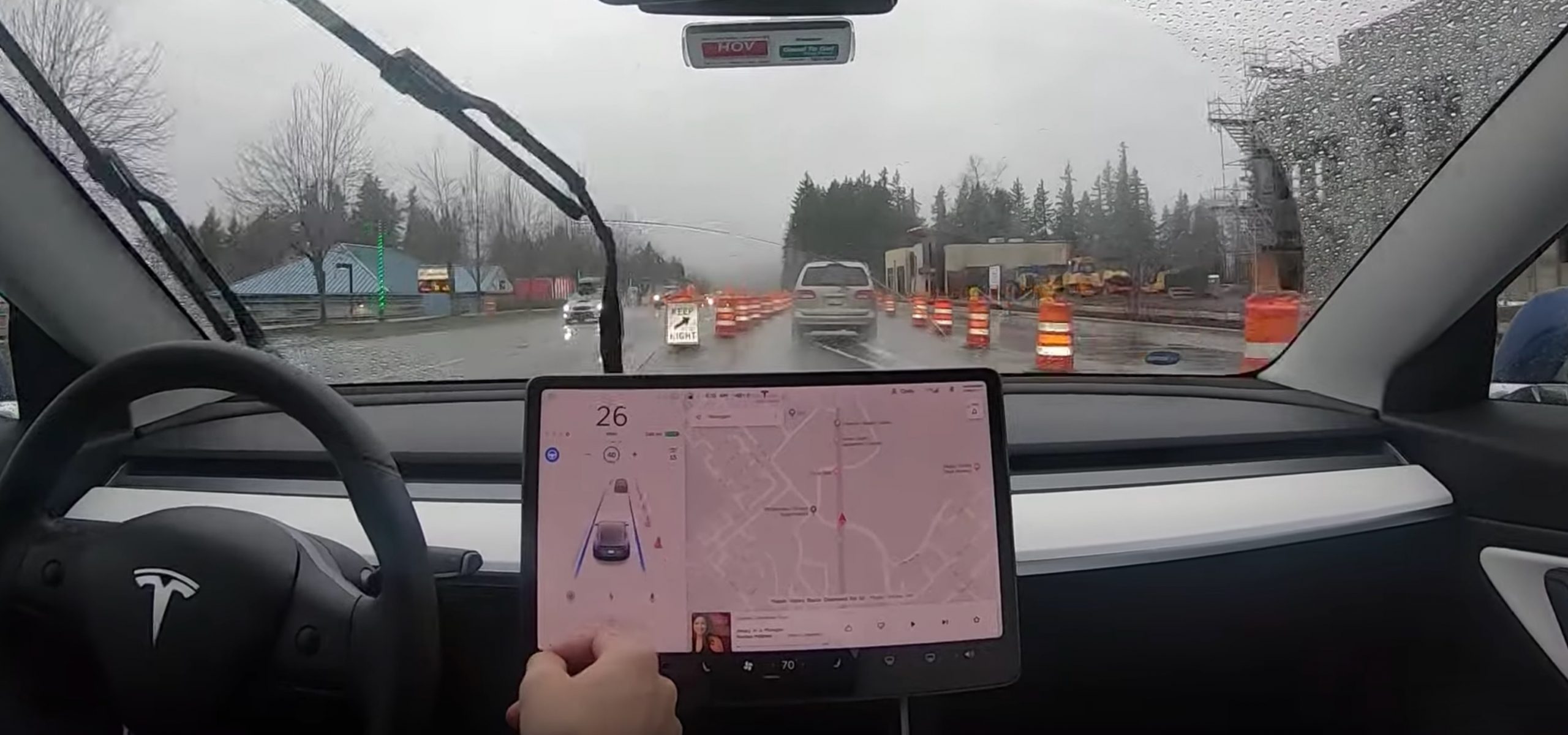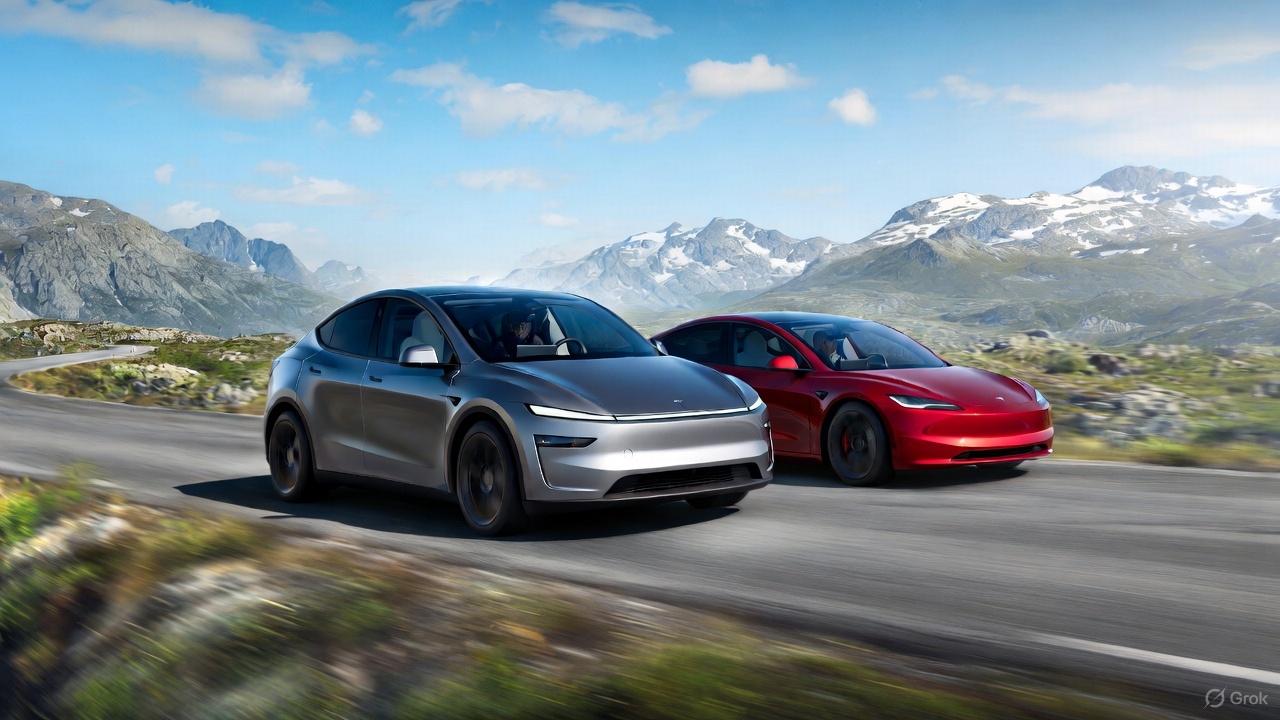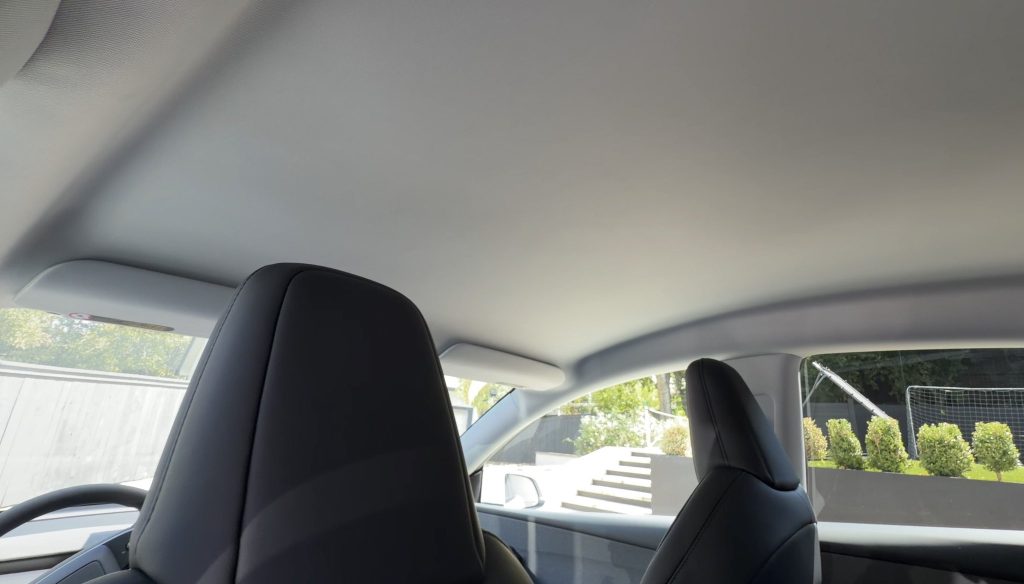

Tesla Model 3
Tesla Autopilot adapts to makeshift construction lane flanked by barriers on both side
A Tesla Model 3 owner has demonstrated the vehicle’s Autopilot system adapt to a busy construction zone with no lane markings.
YouTuber and Tesla enthusiast Cf Tesla took his Model 3 out while chronicling a ride for his “Rate this Drive” series. When approaching a section of the road currently under construction, Cf Tesla was curious to see if the Model 3 would steer away from the numerous barriers set up by crews working on the site. The vehicle recognized a series of cones according to the dash’s Driving Visualization feature and alerted the driver of the oncoming lane shift.
Cf Tesla noted he did not initially recognize the Model 3 shifting away from the construction barriers, but soon realized that the vehicle began maneuvering through a makeshift lane that was flanked by onstruction cones on both sides.
“It’s rerouting itself because of the cones. The road did not just go there…This is not the normal road that we drive on, guys. This is something entirely new and it is figuring it out right now on its own. There’s no lines, it’s using the cones as the “sideline” for this road,” Cf Tesla said.
In October, Tesla CEO Elon Musk announced that the Driving Visualization feature on a vehicle’s dash screen would soon begin to recognize and render traffic cones as an extra safety precaution. The addition of traffic cones and barriers would increase driver awareness by illustrating the barriers that are present on the road on the screen of the car. This is an especially helpful feature at night when visibility is limited to only reflective tape on the cones. This feature was introduced in early November upon the release of Software Update 2019.36.1.
Perhaps the vehicle also recognized that it was traveling within a construction zone due to the multiple cones it rendered on the screen. As a result of this, Cf Tesla was unable to adjust the speed of his vehicle by using the right scroll wheel. This feature is beneficial to pedestrians and workers inside a construction zone. The speed limit inside a construction zone varies from state to state, but the car seemed to recognize that 25 MPH was the maximum speed in the area he was traveling.
Tesla’s Full Self Driving suite was designed to make traveling in a car safer for everyone. Judging upon what took place in this video, it is safe to say the software’s continuous improvements are increasing the reliability and safety of the Full Self Driving capability available to Tesla owners. Including the recognition of construction cones as lane barriers and taking away the freedom to go above the speed limit within a road work zone increases safety for drivers, pedestrians, and workers alike.
You can watch Cf Tesla’s video of his Model 3 recognizing a construction zone and adapting to lane shifts below.

News
Tesla Model 3 and Model Y named top car buys in Norway
Despite growing competition from European and Korean brands, both models stood out for their balance of price, performance, and everyday usability.

Norway’s annual roundup of the best car purchases featured Tesla’s two main sellers this year, with the Model 3 and Model Y securing top positions in their respective segments.
Despite growing competition from European and Korean brands, both models stood out for their balance of price, performance, and everyday usability. The verdict comes as electric vehicle adoption remained above 95% of new vehicle sales in the country.
Tesla Model 3 strengthens its value position
Among compact EVs, the Tesla Model 3 maintained its position as the best overall buy thanks to its strong blend of performance, efficiency, and updated features. Reviewers noted that every trim offered compelling value, especially with the all-electric sedan’s improved cabin ergonomics and the return of the turn-signal stalk, which was one of the few previous complaints among drivers.
The Model 3’s mix of long-range capability, low operating costs, and responsive handling has continued to set the benchmark for compact EVs in Norway. While competitors from Hyundai, Volkswagen, and Peugeot have narrowed the gap, Tesla’s price-to-capability ratio has remained difficult to beat in this segment, Motor.no reported.
“The Model 3 clearly offers the best value for money in the compact class, no matter which version you choose. Now it also gets the turn signal lever back. This eliminates one of the few flaws in a driving environment that many believe is the best on the market,” the publication wrote.
Tesla Model Y claims its crown
The Tesla Model Y emerged as Norway’s top family-car purchase this year. The latest refresh introduced improvements in ride quality, styling, and interior materials, allowing the Model Y to deliver a more premium driving experience without a substantial price increase.
Reviewers praised its spacious cabin, strong safety profile, and practical range, all of which reinforced its appeal for families needing an all-purpose electric crossover. The Model Y remains especially notable given its continued popularity in Norway even as Tesla faces declining sales in other global markets.
“The Model Y is back as the winner in the family class. The upgrade in the new year was even more extensive than expected. It is a slightly more elegant and significantly more comfortable Model Y that solidifies its position as Norway’s best car purchase in the most important class,” the Norwegian motoring publication noted.
News
Tesla axed one of the Model Y’s best features in ‘Standard’ trims: here’s why
Lars Moravy explains why Tesla chose to go with a glass roof in the new Standard trims, despite it not being visible.

Tesla chose to implement a glass roof on the new Model Y ‘Standard’, despite the fact that you won’t be able to see it from the inside.
In the new Model Y ‘Standard’ configuration, one of the biggest changes is the lack of a glass roof, which is one of the more unique features Tesla offers.
How Tesla’s Standard models will help deliveries despite price disappointment
The entire roof of the Model Y’s ‘Premium’ and Performance trims is glass, giving everyone in the car an astounding view of the sky.
However, Tesla chose to cover this up in the new ‘Standard’ trim level. Here’s a look at it:

Credit: ItsKimJava | X
Despite it not being visible from the inside, the roof is still made of glass. It is only visible from the outside. Even if you removed the headliner in the Model Y ‘Standard,’ you would not be able to see the outside, because the glass is opaque:
Fun fact about the Standard Model Y closed glass roof. A Tesla engineer told us that the glass is opaque, so even if you removed the textile lining on the inside, you would not see the outside. 😔 More details to come on our first drive video this Friday. pic.twitter.com/N4uZFlblBB
— Kim Java (@ItsKimJava) October 8, 2025
Tesla’s Vice President of Powertrain, Lars Moravy, commented on the use of glass in the Premium models and how it differs from the glass in the Standard trims:
“All glass is NOT created equal. Remember, the Model Y Premium glass is laminated with silver IR reflective coatings to make it super comfy and reject solar load… the standard is not… plus LOTS of people wanted a closed headliner, always trying to listen (and improve road noise at the same time).”
The decision to cover up the glass while still using it was an efficiency choice. Moravy said Tesla chose to keep the glass for the new Standard models due to “cost, supply chain, and manufacturing efficiency.”
Cost, supply chain and manufacturing efficiency in our factories
— Lars (@larsmoravy) October 9, 2025
Tesla launched the Standard models on Tuesday. The cars were effectively a counter to the loss of the $7,500 EV tax credit.
News
How Tesla’s Standard models will help deliveries despite price disappointment
“What a giant miss,” one person said.
“With all due respect, no way is this what y’all have been hyping for 6 quarters…” another one claimed.
“So…where are the affordable models?” another reply read.

When Tesla unveiled its Standard versions of the Model 3 and Model Y this week, reactions were mixed. Many liked the addition of two new models, but they were also concerned about the price.
“What a giant miss,” one person said.
“With all due respect, no way is this what y’all have been hyping for 6 quarters…” another one claimed.
“So…where are the affordable models?” another reply read.
Tesla launches two new affordable models with ‘Standard’ Model 3, Y offerings
There’s no arguing it: $36,990 and $39,990 for the Model 3 Standard and Model Y Standard were not what consumers had in mind.
But, despite Tesla getting its new offerings to a price that is not necessarily as low as many expected, the two cars still have a chance to assist with quarterly deliveries.
Here’s how:
First-time Tesla buyers will lean toward Standard models
Tesla owners have become accustomed to expecting all the bells and whistles in their cars. Heated seats, ventilated seats, acoustic glass, vegan leather, industry-leading performance, world-class range, and a glass roof are all expected by current or past owners.
But what about new owners?
New owners do not have these high expectations, so to many of those who have not sat in a Tesla or driven one before, they are going to be blown away by the minimalistic looks, capabilities, and features of the Standard models.
The Premium models will feel like the high-end offerings that other automakers also have for sale, except they’ll only be a few thousand dollars more than Tesla’s base models. With other companies, the price for these higher-end trims is $10,000 or more.
The more affordable Standard models will be there, but if buyers want the extra features, they’ll likely be able to justify the extra few thousand dollars.
Tesla’s Standard Models fall under the U.S. Average Transaction Price
Kelley Blue Book releases a new report each month showing the average transaction price (ATP) of all vehicles sold in the U.S. for that month.
The latest report, released on September 10 for the month of August, revealed an ATP of $49,077. This was up 0.5% from July ($48,841) and higher year over year by 2.6%.
Technically, Tesla’s new Standard models fall well under that ATP, meaning they technically do qualify as “affordable.” However, realistically speaking, affordable does not mean “under the national average.”
It means accessible for low-income families, single-parent households, and other groups. This would likely be under $30,000.
Déjà Vu with the Cybertruck Rear-Wheel-Drive
When Tesla offered the Cybertruck RWD, it stripped out many of the best features of the Cybertruck, such as the adjustable air suspension, powered tonneau cover, and interior materials, just to name a few.
It was $10,000 less than the Cybertruck AWD, but many people essentially viewed it as a way to push consumers toward the more expensive variants, since the discount was a better value than missing out on features.
Tesla released the Cybertruck RWD to make the AWD look like a deal
Something similar could happen with the Standard models. With it only being a few thousand dollars less than the Premium Model 3 and Model Y, some consumers will see it as a better option to go with the more expensive trim levels.
Even if they don’t, many car buyers will see it as a deal to grab the Standard versions.









